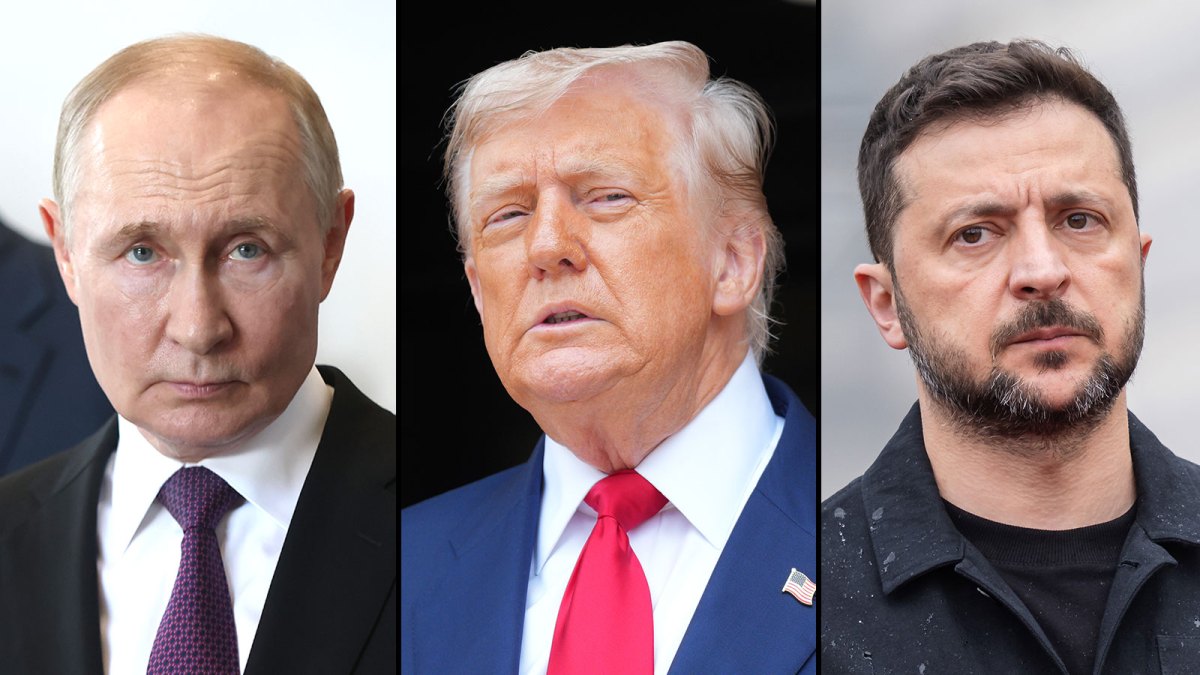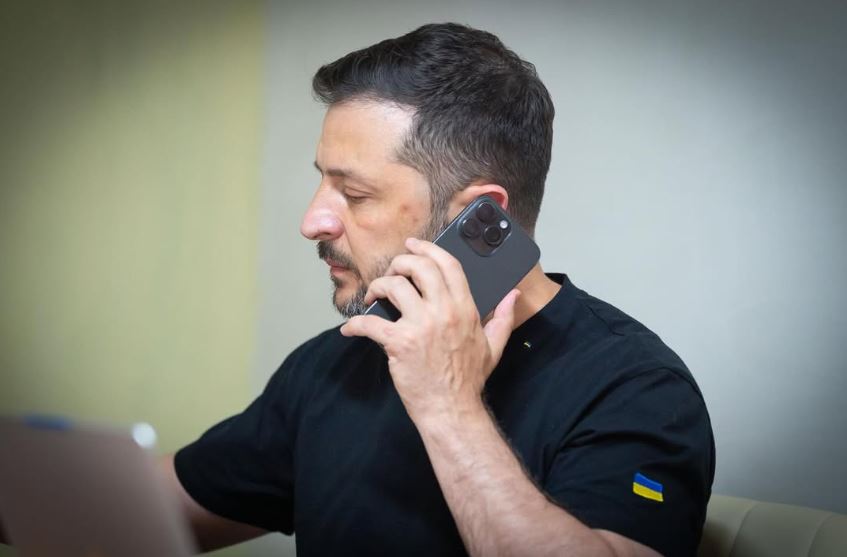President Trump could meet President Putin as soon as next week to discuss a ceasefire deal in Ukraine.
The US president is said to have told European leaders, including Sir Keir Starmer, that he intended to meet the Russian president face to face soon for the first summit between the two leaders since 2018.
He said the initial meeting with Putin could be followed shortly thereafter by a meeting attended by himself, the Russian leader and President Zelensky. His plans were revealed in a call with Starmer, Friedrich Merz, the German chancellor, and Mark Rutte, the Nato secretary-general, according to The New York Times.
The White House said it was “open” to a meeting between Trump, Putin and Zelensky. On Wednesday afternoon the US president said there was a “good chance” of a meeting “very soon”.
He said there was going to be “a lot more” secondary sanctions after he imposed a 50 per cent tariff on India for buying Russian oil. Asked whether a ceasefire in Ukraine was close, Trump said: “I’ve been disappointed before with this one. I’m here to get the thing over with.”
He said Russia had lost more than 20,000 soldiers since the beginning of the year while Ukraine had lost about 9,000. According to the United Nations, more than 6,700 Ukrainian civilians were killed or injured in the first half of this year.
“We’ve had very productive talks today,” he added. Karoline Leavitt, Trump’s press secretary, said that “the Russians expressed their desire to meet with President Trump”, adding he was “open to meeting with both President Putin and President Zelensky”.
Marco Rubio, the US secretary of state, said an “opportunity” for a meeting between Putin, Trump and Zelensky would arise “if we can get what the Ukrainians are willing to accept and what the Russians will accept close enough”. He did not confirm if a meeting would take place next week.
Earlier Steve Witkoff, the US special envoy, held “useful and constructive” talks with Putin in Moscow, the Kremlin said, two days before Trump’s deadline for a ceasefire in Ukraine.
The motorcade thought to be transporting Steve Witkoff through Moscow
YULIA MOROZOVA/REUTERS
Rubio said of the meeting: “Today was a good day, but there is a lot of work to do, I don’t want to exaggerate here. We still have a ways to go there. We are certainly closer today than we were yesterday, but we weren’t close at all.”
Yuri Ushakov, a Russian diplomat, said the two sides had exchanged “signals” on Ukraine and discussed the possibility of developing strategic co-operation between Moscow and Washington, but declined to give more details until Witkoff had reported back to Trump.
Yuri Ushakov gives briefing after discussions
Trump later described the meeting as “highly productive”, posting on his Truth Social platform: “Great progress was made! Afterwards, I updated some of our European allies. Everyone agrees this war must come to a close, and we will work towards that in the days and weeks to come.”
US “secondary sanctions” were still “expected to be implemented on Friday”, a White House official told Reuters, after Trump vowed to impose the punitive measures on Moscow after a ten-day window if it showed no progress on ending its war in Ukraine.
Witkoff and Putin met for about three hours on Wednesday.
Zelensky said he had spoken with the US president after the meeting, in their second phone call this week. Zelensky said “European leaders” were also on the call, where they discussed “what was spelled out in Moscow”.
He posted on X: “Our joint position with our partners is absolutely clear — the war must end.”
Zelensky said that a phone call with President Trump and European leaders discussed Steve Witkoff’s visit to Moscow, adding that “Ukraine will definitely defend its independence”
The head of Russia’s sovereign wealth fund, Kirill Dmitriev, who met Witkoff earlier in the day and walked with him in Zaryadye Park, near Red Square, said on social media: “Dialogue will prevail.”
On Tuesday night, Trump said that the outcome of Witkoff’s talks would inform his next steps and whether he moved ahead with the proposed sanctions and secondary tariffs against Russia and its trading partners, including India.
The president increased US tariffs on India to 50 per cent on Wednesday, representing the most punitive levy of any country in the world alongside Brazil, another country allied with the Kremlin.
On Thursday, Trump’s sweeping new tariffs on more than 90 countries came into effect. “IT’S MIDNIGHT!!! BILLIONS OF DOLLARS IN TARIFFS ARE NOW FLOWING INTO THE UNITED STATES OF AMERICA!,” he said on social media.
Trump, who entered office vowing to broker a swift end to the war, has grown increasingly frustrated with Putin’s refusal to meet his ceasefire demands.
Instead of the full ceasefire that Trump has demanded for months, Putin is said to be considering a partial “air truce”, which would halt the missile and drone attacks on Ukrainian cities that have ramped up in recent months.
• How Ukraine’s air defence warriors take aim at Putin’s drone swarms
More than 6,700 Ukrainian civilians were killed or injured in the first half of this year, according to the United Nations. Last week Trump described Russia’s attacks on Ukraine as “disgusting” and “a disgrace”.
Trump is expected to host the Armenian prime minister, Nikol Pashinyan, and President Aliyev of Azerbaijan, in Washington on Friday, the day of his deadline for Russia, in a renewed push to broker a peace deal between the two Caucasus rivals.
A US official previously said that a framework for a peace agreement could be announced after the meeting in Washington after peace talks in the United Arab Emirates last month yielded no breakthrough. It would be a boost for Trump, who has billed himself as a peacemaker since re-entering office in January. The two South Caucasus countries have been in conflict with each other since the late 1980s over the Nagorno-Karabakh region. It would also fuel speculation that Russia’s influence in the South Caucasus is waning amid the war in Ukraine.
• Why has Trump deployed nuclear submarines?
Meanwhile, Lithuania said on Tuesday that its foreign ministry had written to Nato to request support in strengthening its air defences after a military drone carrying explosives crossed into its territory from Belarus last month.
The letter said that the alliance must show it was ready to defend “every centimetre of its territory”, while an emailed response from Nato said the organisation was monitoring the situation closely.
Lithuania suspects the drone was Russian and aimed at Ukraine, but was disoriented by air defences. It was found crashed in a military training area about 100km (62 miles) from the Belarusian border, containing 4lb of explosives. The drone was said to be a Gerbera drone, a wooden version of the Iranian-designed Shahed kamikaze drone, and another one had entered Lithuania earlier in the month.


